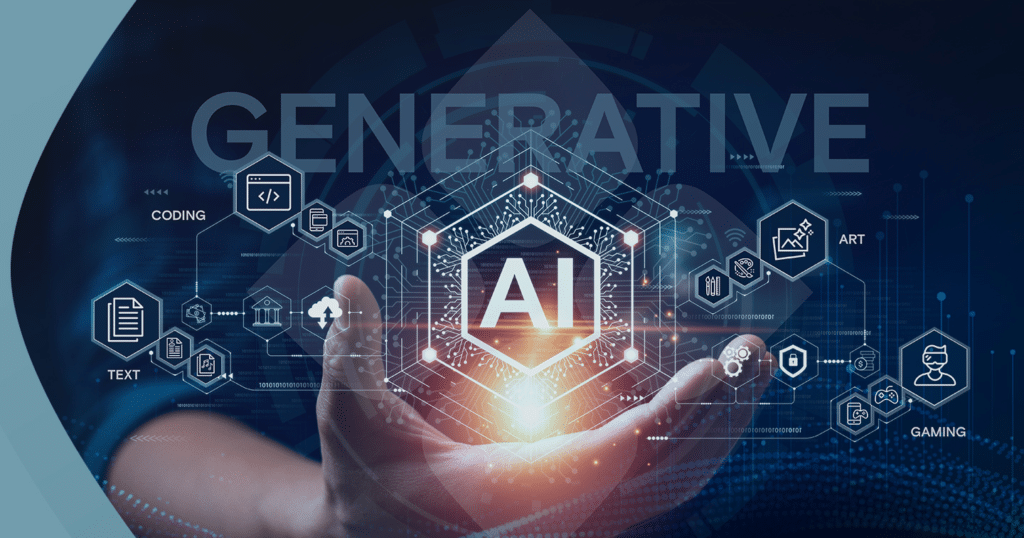Generative AI is a type of artificial intelligence technology that can produce various types of content, including text, images, audio, music, and videos Generative AI is powered by large AI models that can multi-task and perform out-of-the-box tasks, including summarization, Q&A, classification, and more.

How does generative AI work?
Generative AI is like an ultimate tool that learns from stuff people make. It looks at things like words, pictures, and sounds that people have already made. Then it makes its own stuff that looks similar. You give it a starting idea, and it comes up with something new based on what it learned. It can write essays, solve problems, or even create fake pictures or voices that seem real.
Common generative AI applications
Generative AI is like a big brain that handles lots of stuff, making new and ultimate ideas and solutions using words, pictures, and easy-to-understand formats. Generative AI can be used to:
- Improve customer interactions through enhanced chat and search experiences
- Delve into tons of messy information with friendly chat tools and short summaries.
- Help out with boring jobs like answering business requests, translating ads into different languages, and making sure customer contracts follow the rules, plus other stuff.
What are use cases for generative AI?
Generative AI can do lots of different jobs, making all sorts of things. It’s getting easier for everyone to use. Here are some examples:
- Making chatbots to talk to customers and help fix problems.
- Creating fake videos or voices that look and sound like real people.
- Making dubbed versions of movies or educational videos in many languages, so everyone can understand.
- Writing email responses, dating profiles, resumes and term papers.
- Creating photorealistic art in a particular and ultimate style.
- Improving product demonstration videos.
- Suggesting new drug compounds to test.
- Designing physical products and buildings.
- Optimizing new chip designs.
- Writing music in a specific style or tone.
What are the ultimate benefits of generative AI?
Generative AI can help out in lots of business areas. It can make it simpler to figure out what stuff means and even make new stuff on its own. People who make things are trying to figure out how to use generative AI to make their jobs better. Here are some good things about using generative AI:
Making it easier to understand things we already have.
Making new things automatically.
Finding better ways to do our work using this cool technology.
- Creativity amplification
- Time and cost savings
- Hyper-personalization
- Enhanced efficiency and productivity
- Data synthesis
- Realistic simulations
- Adaptive learning
- Enhanced knowledge organization and discovery
- Improve customer experience
What are the limitations of generative AI?
Early implementations of generative AI illustrate its many limitations. Generative AI brings some tough challenges because of how it’s used in different situations. For instance, a simple summary might be easier to read than a detailed explanation with lots of sources. But with the summary, you might not know where the info came from.
Here are some things to think about when using generative AI:
Sometimes, it doesn’t show where it got the info.
It’s hard to tell if the original sources are biased.
Stuff it makes sound real might not always be true.
Figuring out how to adjust it for different situations can be tricky.
Results can gloss over bias, prejudice and hatred.
Some examples of generative AI tools
Generative AI tools exist for various modalities, such as text, images, music, code and voices. Some popular AI content generators to explore include the following:
- Text generation tools include GPT, Jasper, AI-Writer and Lex. example: ChatGPT (openai.com)
- Image generation tools include Dall-E 2, Midjourney and Stable Diffusion.
- Music generation tools include Amper, Dadabots and MuseNet.
- Code generation tools include CodeStarter, Codex, GitHub Copilot and Tabnine.
- Voice synthesis tools include Descript, Listnr and Podcast.ai.
- AI chip design tool companies include Synopsys, Cadence, Google and Nvidia.
Link to share the post: https://initiatives4u.com/what-is-gen-ai-your-ultimate-guide/